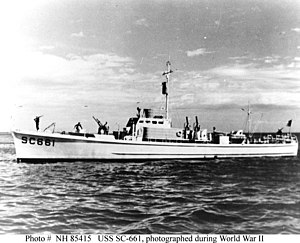SC-497-class submarine chaser
The SC-497 class submarine chasers were a class of 438 submarine chasers built primarily for the United States Navy from 1941-1944. The SC-497s were based on the experimental submarine chaser, USS SC-453. Production began in 1941 and continued until they were succeeded by the SC-1466 class submarine chaser in 1944.
The SC-497s were off-shore patrol and anti-submarine warfare vessels. Seventy of the SC-497s were converted into patrol control crafts (SCC), 18 were converted into coastal mine sweepers (AMC), and 8 were converted into patrol gunboats, motor (PGM).
Sixteen SC-497s were lost and another one was lost after her conversion into a PGM-1 class motor gunboat.
Despite the large number of SC-497s, none are credited with destroying an enemy ship. (USS SC-669 is sometimes incorrectly credited with sinking the Japanese submarine RO-107 on 29 May 1943, but RO-107 was still active on 6 July 1943.)
During World War II, 142 SC-497 class submarine chasers were lent to allies of the United States as part of the Lend-Lease program. Seventy-eight were sent to the Soviet Union, 50 to France, 8 to Brazil, 3 to Norway, and 3 to Mexico.
The HNoMS Hitra (ex-USS SC-718) is preserved at the Royal Norwegian Navy Museum. Some remains of HNoMS Hessa (ex-USS SC-683) and HNoMS Vigra (ex-USS SC-1061) can be seen near the coast of Sweden.
...
Wikipedia

